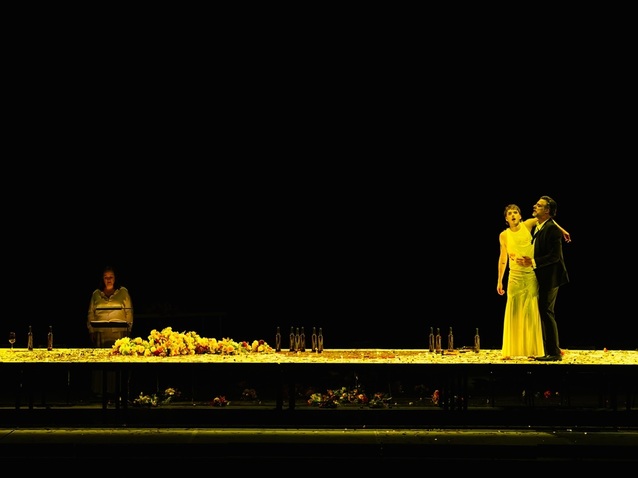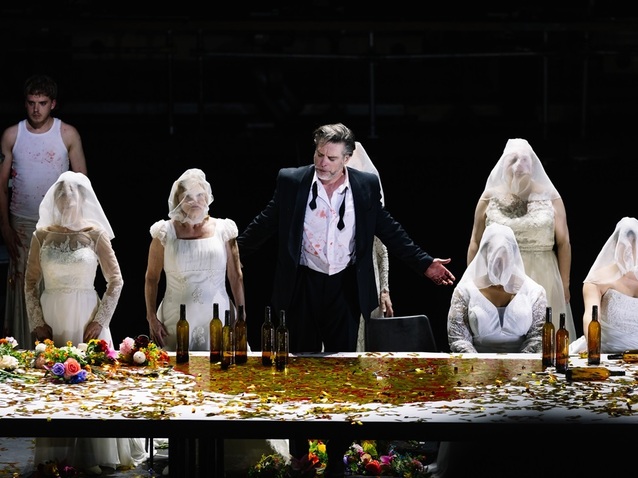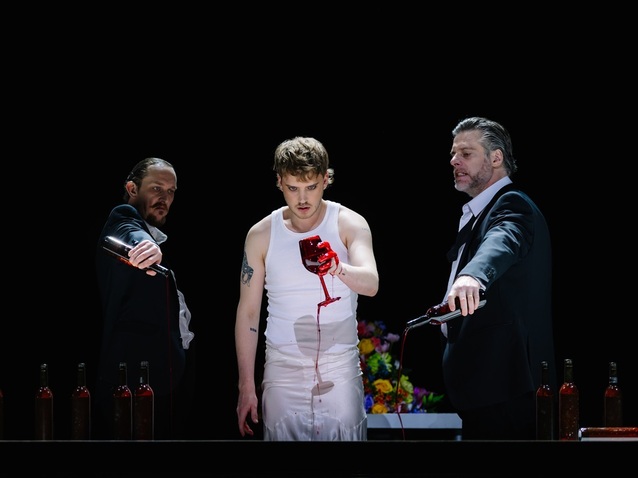 © Nirah Sanghani
© Nirah Sanghani
Béla Bartók’s Duke Bluebeard’s Castle, with a libretto by Béla Balázs, is a one act Symbolist opera, based on the French folk legend as told by Charles Perrault. Bartók originally composed it in 1911, but made quite a few modifications before it premiered at the Royal Hungarian Opera House in Budapest on 24 May 1918. Lasting around an hour, and involving just two singing characters, it tells the story of when Bluebeard brings his new wife Judith to his castle for the first time.
When they arrive all is dark, and Bluebeard actually offers Judith the chance to leave, which she rejects. She insists on all the doors being opened to allow the light to enter, but Bluebeard refuses saying that some private places are not to be explored by others. He asks Judith to love him and ask no questions, but eventually she prevails over his resistance and one by one the doors are opened. The first reveals a torture chamber, the second an armoury, the third a treasury containing great riches, the fourth a secret garden and the fifth Bluebeard’s vast kingdom. In each instance, blood is evident as it has stained the riches and watered the garden.
Bluebeard then pleads with Judith to stop as the castle is now as bright as it can be, but two doors remain to be opened and Judith persists. The sixth reveals ‘a lake of tears’, which leads Judith to believe Bluebeard murdered his former wives, and that is why she can see their blood and tears. She suspects their bodies lie behind the seventh door, which prompts Bluebeard to hand over its key, but what Judith discovers in the final room is not exactly what she had imagined. The work has been interpreted in many ways, with views of Judith ranging from her being the victim to the villain. However, Hungarian conductor István Kertész suggested we should not really relate the opera to the fairytale on which it is based. To him, Bluebeard is Bartók himself, and the opera portrays his personal suffering and reluctance to reveal the inner secrets of his soul, which are progressively invaded by Judith.

Crispin Lord, John Relyea & ENO Chorus, ENO’s Duke Bluebeard’s Castle 2024 © Nirah Sanghani
Joe Hill-Gibbins’s new offering for English National Opera is advertised as a semi-staged concert performance, and, unusually for ENO, is sung in the original Hungarian with English surtitles. Designer Rosanna Vize’s ‘set’ comprises a long dining table, with the empty chairs that run the length of it suggesting that Bluebeard’s previous wives once sat at it. As the drama progresses Bluebeard and Judith face many periods apart, sometimes separated by the entire length of the table. They also, however, share in more intimate moments, which suggest that Judith is telling the truth when she says ‘Szeretlek!’ (I love you). At the same time, it is clear that her ability to be persuasive results from her own strength of character, and on one occasion the two engage in a ‘stare-off’ from opposite ends of the table.
The opera begins with a narration, which poses the question of whether what we are about to see exists in reality or only our minds. While many performances omit this altogether, here actor Leo Bill delivers it with the right combination of mystery and showmanship, and his declaration that outside in the world there is war feels particularly pertinent at present. Bill then remains as a silent presence throughout the drama, which on occasions risks disrupting the very essence of the one to one encounter between Bluebeard and Judith, but overall works well. This is because he actually has a role to play as the butler serving the pair a meal, with each door that is opened being illustrated by him offering a new ‘delight’. For example, the opening of the first to reveal a torture chamber is represented by him and Bluebeard serving wine that resembles blood, with the tremolo effects in the orchestra suggesting the sound of it being poured. The weapons of the second room become cutlery, but in each instance the associated gesture is taken to extremes, thus capturing the notions of determination, single-mindedness and obsession that underpin the opera. Bottle after bottle of wine is poured into the same glass, mounds of cutlery are heaped onto the table, and even the flowers representing the garden behind the fourth door appear to grow more numerous as the bunch they are in is separated out. Ian Jackson-French’s lighting designs are also effective at highlighting, for example, the moment when the castle is at its brightest following the opening of the fifth door, and the plunging of it into darkness once more on the revealing of the sixth.

Leo Bill, Crispin Lord, John Relyea, ENO’s Duke Bluebeard’s Castle 2024 © Nirah Sanghani
John Relyea is an extremely experienced Bluebeard, and his performance on this occasion is as good as ever as he reveals a bass of notable strength, security and richness. Even in concert performances of the work, Relyea has always been good at making Bluebeard’s precise agenda seem highly ambiguous. Now, although the direction places quite specific demands on how he should play the character, he still leaves us uncertain as to how much he really pushes Judith to see this through to the end, or conversely dissuades her from doing so.
On opening night Allison Cook, who was set to play Judith, was indisposed, leading Jennifer Johnston to step in at short notice to sing the role while staff director Crispin Lord silently acted it. Johnston’s mezzo-soprano was rich and full, with an appropriate hint of darkness, and while splitting the part between a singer and actor always risked diffusing the impact of the one to one ‘connection’ between Bluebeard and Judith, it was less of a problem than it could have been. Indeed, the fact that Bluebeard gazed into another man’s eyes, and found his own utterances met, in a sense, with silence only added further layers of intrigue to an opera that can already be interpreted in so many ways. Certainly, the sight of Lord ‘swimming’ in a sensuous way on the table when it created the lake, while Bluebeard hid beneath it, suggested something about who was really drowning in the situation.
The ending provides a few more surprises, which it would be wrong to give away completely. Suffice to say that while it stands to reason that Judith could be the most recent in a very long chain of wives, not having three dilutes the notion of them specifically representing morning, noon and evening and hence Judith’s precise place in the sequence. The very close, however, is more ambiguous than in the original opera and suggests that even at this point Judith is not lacking in agency. The English National Opera Orchestra, under the baton of Lidiya Yankovskaya, captures all of the subtleties and nuances that are in the score while effectively revealing the overall structure of the opera as it modulates from F sharp to C and back to F sharp, which itself represents a move from darkness to light and back.
By Sam Smith
Duke Bluebeard’s Castle | 21 - 23 March 2024 | London Coliseum
the 23 of March, 2024 | Print
Comments